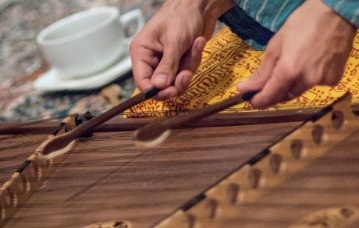
Music is a form of art, entertainment, and ritual that has been explored across nearly all human cultures in recorded history. During our free Spiral Music performance series on Wednesday evenings, many instruments popular in the Himalayas and surrounding regions are put in the spotlight for visitors to discover.
From the erhu to the shamisen, here’s a selection of instruments recently featured in Spiral Music performances. How many of these are you familiar with? Discover these instruments and more at the Rubin, every Wednesday night.
1) Madal

Used mainly for rhythm-keeping in Nepalese folk music, the mandal is the most popular and widely used hand drum in Nepal. It is usually played horizontally in a seated position, with both heads played simultaneously.
Want to see the madal in action? Check out this video of an adorable two-year-old who knows how to keep the beat.
2) Oud

The oud is a pear-shaped stringed instrument, with eleven or twelve strings in five or six courses. Construction of the oud is similar to that of the lute, and the instrument is considered an ancestor of the guitar! Sometimes the oud and guitar are played together to create a unique sound.
3) Erhu

Erhus are two-stringed bowed instruments. They are sometimes known in the Western world as the “Chinese violin” or a “Chinese two-stringed fiddle.” Every day, many New Yorkers are exposed to the erhu’s sound while waiting for the subway, thanks to one of the city’s downtown street performers.
4) Hammered dulcimer (or santoon)

Dulcimers are stringed percussion instruments. The strings of an Indian dulcimer, or santoon, are typically stretched over a trapezoidal soundboard and the player holds a small spoon shaped mallet hammer in each hand to strike the strings.
5) Shamisen

The shamisen is a three-stringed, Japanese musical instrument derived from the Chinese instrument, sanxian. It is played with a plectrum called a bachi. Did you know the shamisen is traditionally used to accompany Japanese kabuki performances? Check out this video from Japan Society to learn more about the shamisen.
6) Harmonium

The harmonium is a keyboard instrument in which the notes are produced by air driven through metal reeds by foot-operated bellows. It’s considered an instrument of French origin, but the harmonium of the Indian subcontinent often features drone stops and a scale-changing mechanism making it distinct in its sound.
Attend an upcoming Spiral Music performance and hear these instruments in person.
Add Your Thoughts
Comments are moderated, and will not appear on this site until the Rubin has approved them.



